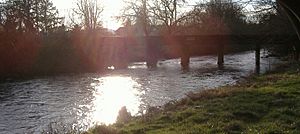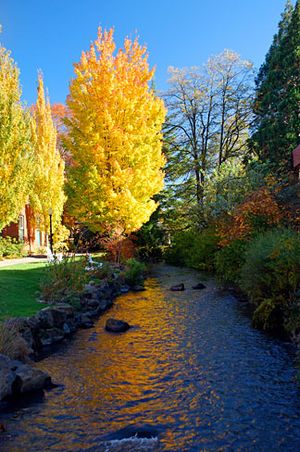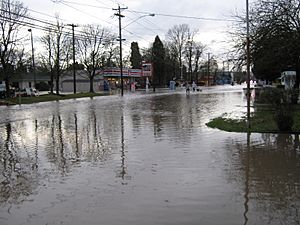Mill Creek (Marion County, Oregon) facts for kids
Quick facts for kids Mill Creek |
|
|---|---|

Mill Creek at Turner
|
|
|
Location of the mouth of Mill Creek in Oregon
|
|
| Country | United States |
| State | Oregon |
| County | Marion |
| Physical characteristics | |
| Main source | Coon Hollow east of Sublimity 841 ft (256 m) 44°49′54″N 122°42′19″W / 44.83167°N 122.70528°W |
| River mouth | Willamette River Salem 125 ft (38 m) 44°57′05″N 123°02′17″W / 44.95139°N 123.03806°W |
| Length | 25.7 mi (41.4 km) |
| Basin features | |
| Basin size | 111 sq mi (290 km2) |
Mill Creek is a river in Oregon, USA. It is about 26 miles (42 kilometers) long. This river flows into the Willamette River. Mill Creek drains an area of about 111 square miles (287 square kilometers) in Marion County.
The creek starts south of Silver Falls State Park. It flows west through several cities. These cities include Aumsville, Stayton, Sublimity, and Turner. Finally, it joins the Willamette River in Salem. The name "Mill Creek" comes from the first gristmill and sawmill built on its banks. These mills were built in 1840–41 by members of the Oregon Mission. A gristmill grinds grain into flour, and a sawmill cuts logs into lumber.
Contents
Where Mill Creek Flows
Mill Creek begins where two smaller streams meet. These are the South Fork Mill Creek and North Fork Mill Creek. This meeting point is in a place called Coon Hollow. It is about 4 miles (6.4 kilometers) east of Sublimity.
The creek flows west. It goes under Oregon Route 22. This is between Sublimity (on the creek's right side) and Stayton (on its left side). About 18 miles (29 kilometers) from its mouth, the creek gets water from Salem Ditch. This ditch is an artificial channel. It brings water from the North Santiam River to Mill Creek.
The creek reaches Aumsville about 15 miles (24 kilometers) from its mouth. Beaver Creek then joins Mill Creek from the right side. This happens just past 12 miles (19 kilometers) from the mouth.
Passing Through Turner
Mill Creek flows through the middle of Turner. Turner is about 10 miles (16 kilometers) from where the creek ends. In Turner, you can find Franzen Reservoir on the right side of the creek. Perrin Lateral also joins the creek from the left. Like Salem Ditch, Perrin Lateral is an artificial channel. It carries water from the North Santiam River to Mill Creek.
Just west of Turner, Battle Creek flows into Mill Creek from the left. Mill Creek then turns north. It passes under Salem–Turner Road about 7 miles (11 kilometers) from its mouth.
Journey to Salem
Less than 2 miles (3.2 kilometers) further downstream, Mill Creek goes under Interstate 5. It then flows next to I-5 for about 1 mile (1.6 kilometers). After that, it passes under Route 22 again and turns northwest. Along the I-5 part, Walter Wirth Lake and McNary Field (Salem Municipal Airport) are on the left. Near Route 22, the area called Four Corners is on the right.
About 3.5 miles (5.6 kilometers) from its mouth, Mill Creek meets Shelton Ditch. This is another artificial channel on the left. It moves water from Mill Creek to Pringle Creek.
As the creek flows through central Salem, it meets Mill Race. This is another artificial channel that sends water to Pringle Creek. This happens about 2.3 miles (3.7 kilometers) from the mouth. After passing a stream gauge (a device that measures water flow) about 1.1 miles (1.8 kilometers) from its mouth, Mill Creek flows by some important places. These include the Oregon State Penitentiary (on the right), the Oregon State Capitol (on the left), and North Salem High School (on the right).
Mill Creek finally enters the Willamette River in downtown Salem. This is across from Wallace Park. It is about 84 miles (135 kilometers) from where the Willamette River joins the Columbia River.
Mill Creek's Watershed
A watershed is the area of land where all the water drains into a specific river or stream. Most of the land in the Mill Creek watershed is owned by private individuals or companies.
In 2006, about 75 percent of the land was used for farming. About 13 percent was used for growing trees (forestry). The remaining 12 percent was urban land, meaning it had cities and towns. Most of the urban areas were found from Turner westward to Salem.
Franzen Reservoir is located along Mill Creek near Turner. This reservoir stores drinking water for the city of Salem. This water actually comes from the North Santiam River. There are also two special channels that divert water from Mill Creek to Pringle Creek. These channels help control flooding in Salem.
History of Mill Creek
Mill Creek got its name because of a sawmill built on its banks. This mill was part of a Methodist mission in the 1800s. Jason Lee started this mission in 1834. It was near what later became the city of Salem. The mill itself was likely built around 1840–41.
To make sure the mill had enough water, a canal was built. This canal connected Mill Creek and the North Santiam River. It was finished in 1857. This canal later became known as the Salem Ditch.
In the mid-1800s, people built artificial structures that changed how the lower part of Mill Creek flowed. Waller Dam was built around 1864 and changed again in 1915. This dam split Mill Creek into two parts. One part was a millrace, which is a channel that directs water to a mill. The other part is sometimes called North Mill Creek. The millrace originally provided power for a woolen mill. It now flows through the campus of Willamette University.
Another diversion canal, called Shelton Ditch, was also built in the mid-1800s. It starts from Mill Creek near the municipal airport. It then flows through the southern edge of downtown Salem. This ditch empties into Pringle Creek near Pringle Park.
In January 2012, there was a lot of rain from a winter storm. This caused many rivers and streams in Oregon to overflow. Mill Creek was one of them. Muddy water from the creek covered some streets and parking lots in Salem. It also flowed into homes and basements. Further upstream, about 40 percent of the city of Turner was flooded. Mill Creek rose 2.5 feet (0.76 meters) above its normal flood level there.
See also
 In Spanish: Mill Creek (Condado de Marion, Oregón) para niños
In Spanish: Mill Creek (Condado de Marion, Oregón) para niños




